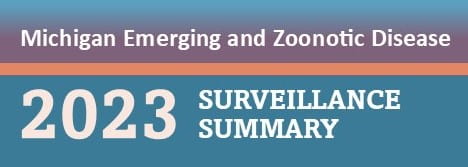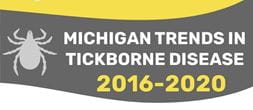The web Browser you are currently using is unsupported, and some features of this site may not work as intended. Please update to a modern browser such as Chrome, Firefox or Edge to experience all features Michigan.gov has to offer.
Lyme Disease
Lyme disease is caused by the bacterium Borrelia burgdorferi and is transmitted by the blacklegged tick. It is the most commonly reported vector-borne disease in the United States and it is spreading across the state of Michigan. Typical clinical signs include flu-like symptoms however, if left untreated may spread to joints, the heart, and/or the nervous system. The majority of cases can be treated successfully with antibiotics. Finding and removing ticks promptly can prevent Lyme disease.
-
Who is at risk?Lyme Disease Map 2015Anyone living or recreating where Lyme disease ticks may be present could become infected. Lyme disease is endemic (prevalent) in the Northeast, Northwest, and much of the North Central United States, including Wisconsin, Illinois, Indiana, and Pennsylvania.View map2020 Michigan Lyme Disease Risk Map thumbnail imageIn Michigan's Upper Peninsula, multiple counties have well-established tick populations, due in part to the close proximity to Wisconsin. In the Lower Peninsula, the first confirmed infected population of blacklegged ticks were detected in 2002 along the west coast. Since that time, the tick and the bacterium have been invading northward along the Lake Michigan coast. However, currently, infected ticks are spreading and being detected across several portions of the Lower Peninsula.View map
-
Signs and Symptoms
Untreated Lyme disease can produce a wide range of symptoms, depending on the stage of infection. These include fever, rash, facial paralysis, and arthritis.
Early Signs and Symptoms (3 to 30 Days After Tick Bite)
- Fever, chills, headache, fatigue, muscle and joint aches, and swollen lymph nodes may occur in the absence of rash
- Erythema migrans (EM) rash:
- Occurs in approximately 70 to 80 percent of infected persons
- Begins at the site of a tick bite after a delay of 3 to 30 days (average is about 7 days)
- Expands gradually over several days reaching up to 12 inches or more (30 cm) across
- May feel warm to the touch but is rarely itchy or painful
- Sometimes clears as it enlarges, resulting in a target or “bull’s-eye” appearance
- May appear on any area of the body
- Does not always appear as a “classic” erythema migrans rash
- Occurs in approximately 70 to 80 percent of infected persons
Later Signs and Symptoms (days to months after tick bite)
- Severe headaches and neck stiffness
- Additional EM rashes on other areas of the body
- Facial palsy (loss of muscle tone or droop on one or both sides of the face)
- Arthritis with severe joint pain and swelling, particularly the knees and other large joints.
- Intermittent pain in tendons, muscles, joints, and bones
- Heart palpitations or an irregular heart beat (Lyme carditis)
- Episodes of dizziness or shortness of breath
- Inflammation of the brain and spinal cord
- Nerve pain
- Shooting pains, numbness, or tingling in the hands or feet
- Fever, chills, headache, fatigue, muscle and joint aches, and swollen lymph nodes may occur in the absence of rash
-
Diagnosis and Testing
What should I do if I think I might have Lyme disease?
If you believe you may have Lyme disease, consult with a healthcare provider for evaluation and diagnosis. If you have the tick that was attached to you, bring it with you to your appointment as the physician may be able to properly identify it. Alternatively, Michigan Department of Health and Human Services can also identify the tick(s) at no cost (see below).
How is Lyme disease diagnosed?
Lyme disease is diagnosed based on signs and symptoms in addition to a history of possible exposure to infected blacklegged ticks.
A healthcare provider may order laboratory blood tests for those individuals experiencing symptoms of Lyme disease in order to assist in proper diagnosis. Additionally, Michigan Department of Health and Human Services offers testing at no cost to Michigan citizens, when ordered through their healthcare provider (see link below for information).
MDHHS BOL Mosquito-Borne and Tick-Borne Disease Testing
What should I do if I have a tick that I want to have identified?
Knowing what kind of tick bit you may be important in knowing what your risk of disease is. The Michigan Department of Health and Human Services (MDHHS) provides tick identification at no charge to Michigan citizens. There are two ways to have a tick identified, 1) By submitting a photo of your tick, or, 2) by sending the tick to the MDHHS for microscopic identification.
Click HERE for instructions on how to submit a photo of your tick for identification
Click HERE for instructions on how to ship a tick to the MDHHS for microscopic identification
MDHHS Bureau of Laboratories - Lab Services Guide
Lyme disease information for clinicians
For guidelines, a webinar, and resources please see our Lyme information webpage.
-
Treatment
Early diagnosis and proper antibiotic treatment of Lyme disease is important and can help prevent late Lyme disease. The following treatment regimens reflect CDC’s interpretation of the most current data for four important manifestations of Lyme disease. These regimens are consistent with guidance published by the by the Infectious Disease Society of America, American Academy of Neurology, and American College of Rheumatology.
Erythema migrans
Neurologic Lyme disease
Lyme carditis
Lyme arthritis
Some patients report persistent symptoms of pain, fatigue, or difficulty thinking even after treatment for Lyme disease. The state of the science relating to persistent symptoms associated with Lyme disease is limited, emerging, and unsettled.
Additional research is needed to better understand how to treat, manage, and support people with persistent symptoms associated with Lyme disease. In light of these research gaps, recommendations for treatment of persistent symptoms in people previously treated for Lyme disease are not provided here. -
Prevention
-
Educational Materials and Guidance Documents
- Michigan Lyme Disease Risk Map
- Michigan Tick ID Card Pocket-sized card for identifying common ticks in Michigan. Information regarding tick removal and tick-bite prevention.
- Tick Removal
- MDHHS Lyme disease information for Clinicians Guidelines and resources for healthcare providers.
- Tickborne Diseases of the U.S. (CDC)
- Ticks and Your Health Brochure describing Lyme disease and other tick-borne diseases in Michigan. Other topics covered include tick-bite prevention, preventing ticks on pets, and landscape techniques to minimize tick risk.
- CDC: Guidance for Clinicians: Recommendations for Patients After a Tick Bite
- Centers for Disease Control and Prevention Lyme Disease Printed Materials
- Lifecycle of Blacklegged Ticks
- Lyme disease: What you need to know (CDC)
- CDC: What To Do After a Tick Bite
- Michigan's Five Most Common Ticks Ticks are significant vectors (carriers) of pathogens that cause human and animal disease. In Michigan, tick-borne diseases are rare, but they do occur and can be serious if not properly diagnosed and treated.
- Communicable Disease Division Publication Order Form The following Lyme disease publications can be ordered free of charge to Michigan local health departments, healthcare providers, social services agencies, and others:
- Ticks and Your Health Booklet
- Be Aware Trail Head Posting
- Tick Bite Prevention in Michigan's Outdoors Poster
- Tick Bite and Lyme Disease Prevention in Michigan Poster
- Michigan Tick ID Card (2"x3.5" business card size)
- Tick Submission Kit
- Poster: Looking for a bull's-eye rash? Look again-erythema migrans can take many forms.
-
Data, Statistics, and Maps
Michigan Lyme Disease Maps and Statistics:
Map of cases by county
Michigan citizen submitted ticks by county
Michigan Lyme Disease Risk Map 2021
Michigan Lyme Disease Risk maps, historical compilation 2014-2021National Lyme Disease Maps and Statistics:
Maps 2001-2019
Table of cases per state 2010-2019
Graphs of cases by: year, age/sex, month, symptom



